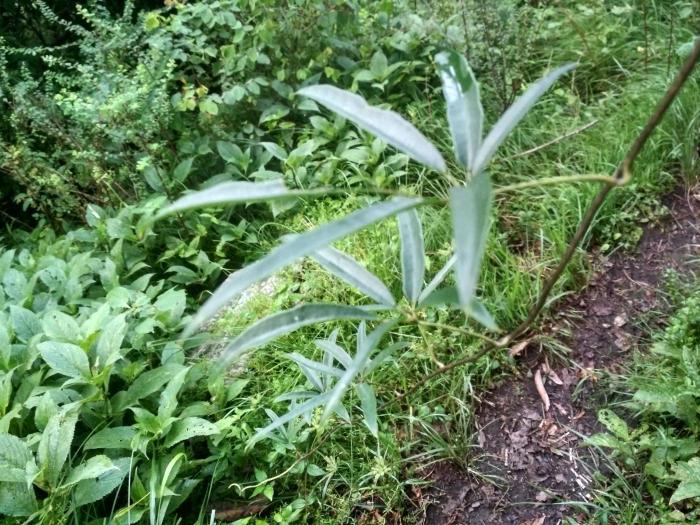Chinese Staunton Vine
(Stauntonia latifolia)
Chinese Staunton Vine (Stauntonia latifolia)
/
/

Ramnarayan K
CC BY 4.0
Image By:
Ramnarayan K
Recorded By:
Copyright:
CC BY 4.0
Copyright Notice:
Photo by: Ramnarayan K | License Type: CC BY 4.0 | License URL: http://creativecommons.org/licenses/by/4.0/ | Rights Holder: Ramnarayan K | Publisher: iNaturalist | Date Created: 2020-08-06T18:26:57-07:00 |



Estimated Native Range
Summary
Stauntonia latifolia, commonly known as Chinese staunton vine, is an evergreen vine native to forest margins, valley woodlands, and thickets in China and the Himalayas. It can reach lengths of up to 26 feet (8 meters) and is known for its vigorous climbing habit. The plant features leathery, dark green leaves and bears fragrant, purple-tinged white flowers in the spring, which are considered moderately showy. Following flowering, it produces oblong, edible fruit that may be up to 3.5 inches (9 cm) long.
Chinese staunton vine is valued for its ornamental foliage and fragrant flowers, making it a popular choice for trellises, arbors, and as a screening plant in gardens. It thrives in moist, well-drained soils and prefers partial shade, though it can tolerate full sun in cooler climates. In cultivation, it requires support to climb, and regular pruning to maintain its shape and promote air circulation, which helps prevent fungal diseases. While it is not known for aggressive roots, it can become quite heavy as it matures, so sturdy support structures are recommended. Stauntonia latifolia is not typically invasive outside its native range, but gardeners should monitor its growth to ensure it doesn’t overtake nearby plants.CC BY-SA 4.0
Chinese staunton vine is valued for its ornamental foliage and fragrant flowers, making it a popular choice for trellises, arbors, and as a screening plant in gardens. It thrives in moist, well-drained soils and prefers partial shade, though it can tolerate full sun in cooler climates. In cultivation, it requires support to climb, and regular pruning to maintain its shape and promote air circulation, which helps prevent fungal diseases. While it is not known for aggressive roots, it can become quite heavy as it matures, so sturdy support structures are recommended. Stauntonia latifolia is not typically invasive outside its native range, but gardeners should monitor its growth to ensure it doesn’t overtake nearby plants.CC BY-SA 4.0
Plant Description
- Plant Type: Vine
- Height: 5-20 feet
- Width: 5-20 feet
- Growth Rate: Moderate
- Flower Color: White
- Flowering Season: Spring
- Leaf Retention: Evergreen
Growth Requirements
- Sun: Full Sun, Part Shade
- Water: Medium
- Drainage: Medium
Common Uses
Border Plant, Low Maintenance, Potted Plant, Rock Garden, Showy Flowers
Natural Habitat
native to forest margins, valley woodlands, and thickets in China and the Himalayas
Other Names
Common Names:
Scientific Names: , Stauntonia latifolia, Holboellia latifolia, Holboellia latifolia subsp. chartacea, Holboellia latifolia subsp. chartacea, Holboellia latifolia var. latifolia, Holboellia ovatifoliolata, Hoya cavaleriei, Stauntonia latifolia, Stauntonia latifolia,
GBIF Accepted Name: